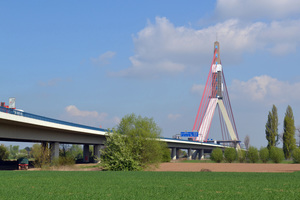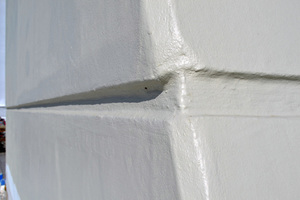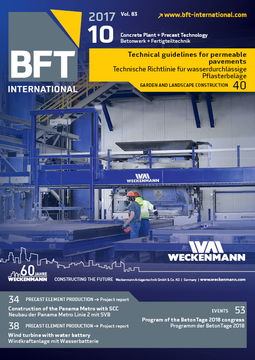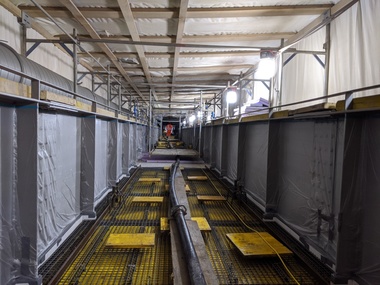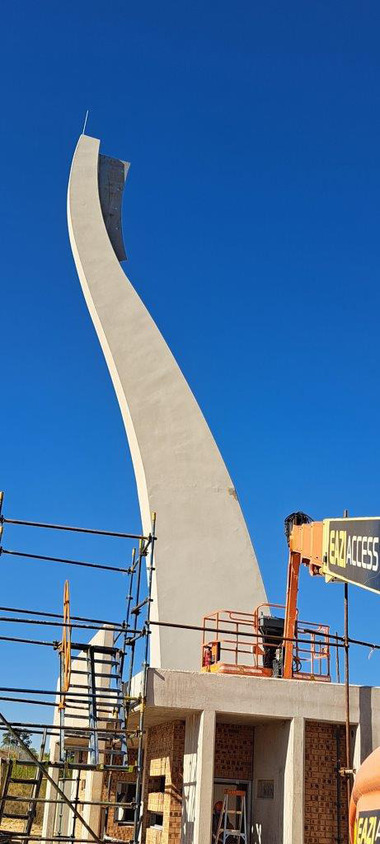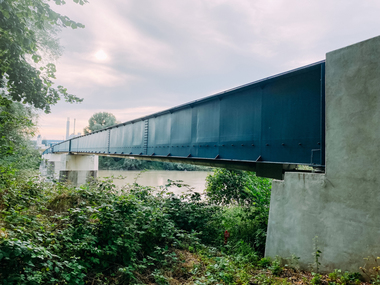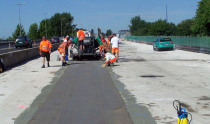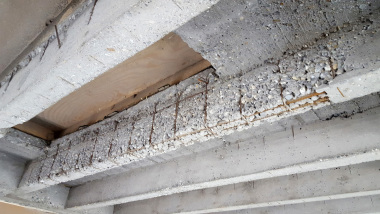Highest cable-stayed bridge in Germany undergoes rehabilitation
The pylon of Fleher Brücke resembles the letter Y extending over the Rhine River in upside-down position. This pylon fulfils an important task because it takes up the stay cables that hold the bridge in place; it is thus a key load-bearing component of the entire structure. After almost 40 years in service, the reinforced concrete used for this pylon was in dire need of repair and rehabilitation. Landesbetrieb Straßenbau NRW, the road construction agency of the German State of North Rhine Westphalia, thus commissioned the rehabilitation of this concrete giant to ensure the stability of Fleher Brücke in the long term. Premium StoCretec products were used for this purpose.
Fleher Brücke was put into service in 1979. This bridge creates the A 46 highway crossing of the Rhine River between Neuss and Düsseldorf. The 1,165 meter long cable-stayed structure is held in place by a centrally arranged pylon. This reinforced-concrete pillar extends to a height of 146 m and is thus the highest of its kind in Germany. Daily loads and exposures due to traffic, weather conditions and pollutants put more and more pressure on the concrete. A comprehensive inspection carried out in 2010 revealed damage to the structural fabric, including spalling, cavities, cracks and partially exposed reinforcement. This damage pattern necessitated urgent rehabilitation of the bridge in order to continuously ensure the structural stability of the pylon and thus of the entire structure.
Finish coat keeps the water out
Prior to the commencement of construction work, the pylon was scaffolded completely, which required a short-term closure of the entire highway. The specialist contractor then inspected the concrete again for spalling, cracks and cavities. Damaged parts needed to be removed and exposed reinforcement had to be de-rusted, followed by application of the StoCrete TK anti-corrosion agent. Cracks were completely filled with the StoJet IHS 93 low-viscous synthetic resin. This epoxy lends full stiffness back to the concrete element, thus enabling it to again absorb the loads it was originally designed for.
Damaged concrete areas were reprofiled manually using the polymer-modified StoCrete TG 204 repair mortar. StoCrete TH 200 was applied as a bonding agent between the existing concrete and the concrete substitute. Workers also added StoCrete TF 200/204 as a scratch coat to achieve a homogeneous appearance of the concrete surface. Both the concrete substitute and the leveling mortar ensure effective long-term protection under freeze/de-icing salt impact.
A StoCryl V 100 finish coat was applied in two layers to provide additional protection and to preserve the structural fabric in the long term. This finish prevents water, chlorides and carbon dioxide from penetrating into the structure, which would otherwise be the main causes of concrete damage. All applied StoCretec products were thoroughly tested as part of a complete system and perfectly adjusted to each other. They are compliant with the EN 104 standard and are subject to continuous quality control.

